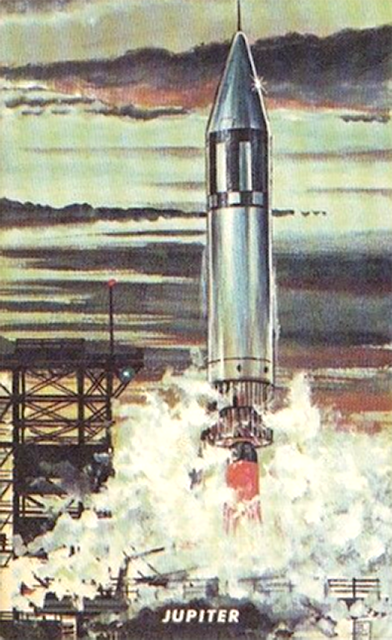1958 Flying A Service : Missiles
Flying A Service Missiles cards were distributed in 1958 by Tidewater
Oil Company. The perforated cards were attached to road maps from participating Flying A Service stations. The six-card series features
illustrations and colored photographs of ballistic missiles developed by the United States. The Atlas, Thor,
and Jupiter family of weapons were also used as space launch vehicles.
The U.S. Army and Navy used the PGM-19 Jupiter to conduct biological experiments in 1958 and 1959. On December 13, 1958, Bio-Flight No. 1 launched from Cape Canaveral aboard Jupiter AM-13. The nose cone contained a squirrel monkey named Gordo, also known as Old Reliable. Gordo travelled to an apogee of 290 miles (467 km) and a distance of 1,300 miles. The parachute failed over the Atlantic Ocean and Gordo was not recovered.
Bio-Flight No. 2 carried the first primates to safely return from a spaceflight. Miss Able, a rhesus macaque, and Miss Baker, a squirrel monkey, were launched aboard the nose cone of Jupiter AM-18 on May 28, 1959. The Bio-Flight No. 2 experiment travelled to an apogee of about 300 miles (483 km) before splashing down in the Atlantic Ocean. Miss Able died from anesthesia during a post-flight operation on June 1, 1959. The preserved body is held by the Smithsonian National Air and Space Museum .
The U.S. Army and Navy used the PGM-19 Jupiter to conduct biological experiments in 1958 and 1959. On December 13, 1958, Bio-Flight No. 1 launched from Cape Canaveral aboard Jupiter AM-13. The nose cone contained a squirrel monkey named Gordo, also known as Old Reliable. Gordo travelled to an apogee of 290 miles (467 km) and a distance of 1,300 miles. The parachute failed over the Atlantic Ocean and Gordo was not recovered.
Bio-Flight No. 2 carried the first primates to safely return from a spaceflight. Miss Able, a rhesus macaque, and Miss Baker, a squirrel monkey, were launched aboard the nose cone of Jupiter AM-18 on May 28, 1959. The Bio-Flight No. 2 experiment travelled to an apogee of about 300 miles (483 km) before splashing down in the Atlantic Ocean. Miss Able died from anesthesia during a post-flight operation on June 1, 1959. The preserved body is held by the Smithsonian National Air and Space Museum .
| Flying A Service : Missiles |
|---|
| The ICBM Atlas |
| The IRBM Thor |
| The Jupiter |
| The Nike Hercules |
| The Polaris |
| The Regulus II |

.png)